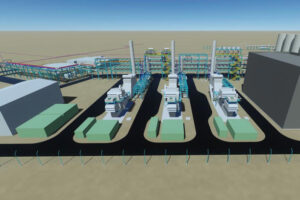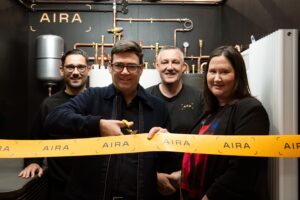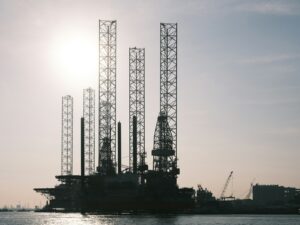ALUNA: the clock that’s aiming to be a beacon for a more sustainable future
Mark Pniewski and ALUNA’s designer, Laura Williams, examine the environmental lessons we can learn from the development of the world’s most accurate lunar clock
As environmental issues move higher up the news agenda, projects which highlight today’s environmental challenges and provide sustainable solutions are taking centre stage. ALUNA is one such project that is being developed in central London with the aim of providing an eco-friendly and sustainable public waterfront realm and landmark clock for the modern era.
What and where is ALUNA?
Designed by artist Laura Williams as a place of celebration and connection, ALUNA is the world’s largest Moon and tide clock, a £14m zero-carbon cultural landmark and Thameside civic space. The clock will be built on the historic Greenwich Peninsula waterfront in London’s Docklands, adjacent to The O2 and opposite Canary Wharf.
Larger than Stonehenge at 40m wide and 13m high, the clock’s structure is made up of three vast translucent recycled glass rings that track the Moon’s cycles, and influences on the Earth, with slowly moving light. The National Oceanography Centre has designed ALUNA’s master time code to tell the world’s most accurate lunar time, and the structure’s geometry relates very precisely to its function.
Regenerative design
Utilising renewable and sustainable technologies is crucial to the project and regenerative design and engineering techniques will be used throughout. The project will be built to last using 100% recycled glass and steel, illuminated by low-energy LEDs, and powered by the Sun and Moon using onsite solar photovoltaic panels and tidal turbines. ALUNA will be designed to be upgradeable for future generations. Although not necessarily new techniques, few in the industry are yet to wholly embrace regenerative design – something we hope will change. For our environment to be built with later generations in mind, sustainability is paramount.
Technological techniques
Throughout ALUNA’s development, innovative technology has been used in planning phases as we work to put the wheels in motion for this ambitious and challenging superstructure. Utilising cutting-edge technology and digital design, an immersive VR experience using Google Cardboard has been created to explore the dynamic installation.
Several 3D 360° visualisations of ALUNA were created to show the workings of the tide cycle and lighting, bringing the waterside landmark to life and highlighting the potential of the project. This work is key not only to securing funding for the project, but also allows the public to view the project in its incarnations and progressions.
In addition to this visual exploration, and increasingly used in the design and planning of complex structures and urban developments, atmospheric parameters such as pressure, velocity and temperature are numerically simulated using a technique known as computational fluid dynamics (CFD).
In conjunction with 3D models of the structures and surrounding cityscape, climate data and wind patterns can be predicted; pressures on facades and wind velocities at street level can be accurately calculated and accounted for in designs. Using these technologies will enable us to make more informed decisions earlier in the engineering process.
The results of ALUNA’s CFD engineering analysis can be virtually experienced using RAMView360, a bespoke panorama viewer created by Ramboll’s engineering simulation team. This sort of integration and publication of technology is another point which should become more typical in years to come – as environmental impacts become more of a priority, completing multifaceted assessments will become necessary, as will demonstration of your commitment to the cause.
Community developments
If we can use certain technological methods and materials to make a project or development more or less environmentally beneficial, the other key consideration in the planning phase should be the surrounding community.
ALUNA demonstrates an approach that plans for community outreach and education as a key part of its existence, with long-term participatory cultural and educational programmes planned around the development. These will be designed to empower individuals and their community to be active agents for social and environmental change, through international festivals, the performing arts, formal and informal learning, dialogue and debate.
London’s cultural diversity is linked to its tidal location, innovation in navigation and timekeeping – specifically the understanding of the Moon and tides at the Royal Observatory Greenwich.
Many of London’s vibrant cultural festivals are timed by the Moon, from Easter, Passover, Eid and Diwali through to the gamut of Chinese, Islamic, Jewish, Vietnamese and Hindu New Years. This project hopes to focalise these cultural touchpoints around the moon’s power, and to remind both locals and visitors of this connection.
Another key driver for ALUNA has been to raise awareness amongst the local community of our relationship with the sea, a force that has shaped our past and will determine our future. With climate change comes rising tides, and following the COP21 agreement, we urgently need to understand nature’s rhythms, transform our cultures and technologies, and transition together to a green, socially just future.
ALUNA presents an exciting opportunity to introduce young people to a variety of design and engineering disciplines, exploring how school subjects such as the sciences and maths can be applied in the civic realm for climate change mitigation, cutting-edge research and sustainable design solutions.
A first education pilot is already in development and will be delivered by Ramboll STEM Ambassadors in local primary schools. This educative and open approach to projects as they move through development and construction stages can and should be adopted by more developers.
By embracing technology, using regenerative engineering and design methods, actively engaging with the community and embracing social impact, ALUNA aims to showcase some of the ways in which built environment projects can modernise and prioritise the environment as a matter of urgency. We believe that such steps will continue to grow in importance for our industry, and hope developers and engineers alike will begin to recognise this.















